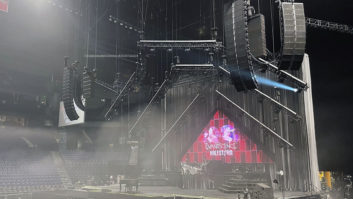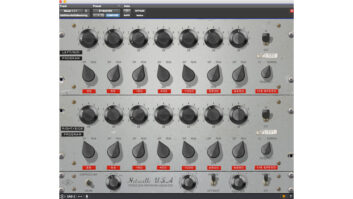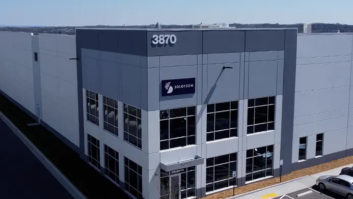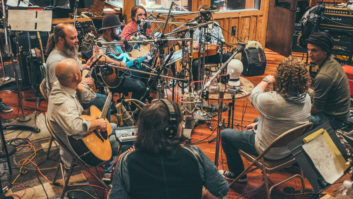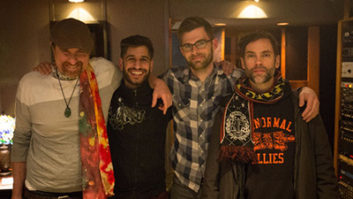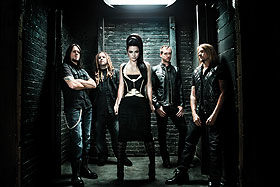
Evanescence, from left: Troy McLawhorn, Terry Balsamo, Amy Lee, Tim McCord and Will Hunt
It’s been five years since Evanescence put out its last album, The Open Door, which was also the hard-rockers’ first Number One album. Since then, there have been changes in the group: In the middle of a year-long world tour to support that disc, rhythm guitarist John LeCompt and drummer Rocky Gray departed and were replaced by two members of Dark New Day—guitarist Troy McLawhorn and drummer Will Hunt. Both drifted in and out of the band over a period of a couple of years before ultimately joining Evanescence for good. The core of singer/songwriter/keyboardist Amy Lee, lead guitarist Terry Balsamo and bassist Tim McCord remained intact.
During the first half of 2010, Evanescence worked on a new album with producer Steve Lilywhite, but ultimately, Amy Lee decided against releasing what she termed an “experimental” record; instead, the band regrouped several times and developed some new material together. After searching for an appropriate producer to make a new, from-scratch album, the group ultimately hired Nashville-based Nick Raskulinecz (pronounced “Rask-a-len-iks), whose long and impressive resume includes sonically adventurous albums by the Foo Fighters, Alice in Chains, Coheed and Cambria, Stone Sour, The Deftones, Rush and many others. Paul Fig (Figueroa), who has worked on numerous projects with Raskulinecz since assisting on an album by The Exies at Sound City in L.A. back in 2004, engineered the sessions at Nashville’s Blackbird Studios this past spring. The album is simply titled Evanescence.
“Evanescence’s camp called me and asked if I might be interested in working with them,” Raskulinecz explains. “Never having been a fan of the band, I said yes anyway because you never know. And when they sent me a few demos, I really heard some stuff that I thought could be great. That’s how it starts with any project for me.
“Amy and I had a great meeting,” he continues. “She came down from New York, and we met at Blackbird in the studio that I had a vision for making the record in—Studio D. I’ve made other records there before and I thought she would love the vibe and the ‘hang’ of it. It’s such a great room to be creative in and make music in. So we just sat in the control room for a couple of hours and talked, and she asked me all kinds of questions. I think I had five or six songs at that point and I told her my ideas and what I thought about them. And she liked a lot of what I had to say and didn’t like a little bit of what I had to say, but she accepted it. Then I think she had a couple of other meetings with other dudes after me, but I got the call a few days later telling me they’d picked me.” Lee and the band had apparently been most impressed by the producer’s recent work with Alice in Chains and The Deftones.
Once the ball was rolling, Raskulinecz and the group spent a month at SIR in Nashville—five days a week, eight hours a day—making sure the songs and arrangements were as strong as they could be, “and then from there you really dive into the details of what everybody is doing individually,” he says.
“Amy knows what she wants. She’s very focused and she’s very passionate about her songs and her music,” he continues. “It all starts with the piano melodies and the parts and the vocals, and then it goes from there. It’s Amy’s vision, but along with Tim and Terry. When I got involved, those three were kind of the core of all the songs I had heard. But I know when Will Hunt, the drummer, got involved, things evolved a little bit more, and he was in on some of the songwriting. And then when Troy came on board, he was really important in bringing some great ideas to the table. Everybody in Amy’s band is a great musician and a great guy. Will Hunt is an animal on the drums; he’s amazing. The rhythm section of Will and Tim is on fire, man!
“Going into this record, before we even went into Blackbird, I knew that sonically it was going to be a big, dense album, so me and Paul Fig were very aware of that. The recording of it was very calculated. We knew that there would be lots of tracks—drums, drum samples, a big bass sound, two guitar players, piano, tons of vocals, harmonies and overlapping tracks—just massive. So it was a lot to organize and keep track of, but at the same time I wanted to make sure that by the time you got to the mix you could still hear everything.”

Producer Nick Raskulinecz and vocalist Amy Lee working in Blackbird Studios
TAKE UPON TAKE UPON TAKE
Still, even with all the layering of parts (we’ll get to that momentarily), it was important for Raskulinecz and Fig that the base of the album be completely performance-oriented. “It wasn’t, ‘Play it once or twice and go have a snack; I’ll sit here and edit it for the next five hours,’” Raskulinecz says with a chuckle. “It was more like, ‘That was all right. Let’s do it again—take 25.’ It was lots of takes and comping from there, and then going back and punching in.
“The way we did it is we made stripes for everything. We would get scratch guitar, scratch bass and scratch vocals just with a click, and then we would track the drums to that.”
Adds engineer Fig, “Nick likes to concentrate on the performance, so it’s usually beginning to end. If there are tough sections, maybe we’ll come in halfway. Generally we’ll have six or seven playlists of drums we like and we’ll comp something together from those performances. But he really doesn’t want it to sound like somebody chopped it up and then slapped it together.” Hunt plays a 26-inch kick drum, which Fig miked with a Sennheiser e 602 on one side and a FET 47 on the other. Toms were captured with AKG 451s set in hypercardioid.
Lee would sing her scratch vocals in the control room of Blackbird Studio D, without headphones, through a Shure SM7. “When we did the vocals for real, obviously we did it differently,” Raskulinecz notes. “She’s an amazing singer—she can sing all day long.” Fig: “There were a couple of days when Nick had to be somewhere else and I was working with her on vocals and I was worried maybe I was pushing her too hard. But she’s like an athlete. She stepped to the plate and hit it out of the park.”
Raskulinecz and Fig did a shootout to choose the right vocal mic for Lee—the winner was a long-body Neumann U47 that is, coincidentally, Blackbird owner John McBride’s favorite U47. (Fig: “That mic was mind-blowing—it could handle anything she could belt at it.”) That was used for all of Lee’s leads; her backing vocals—and there are many of them—went through a Telefunken 251. “Amy is really singing at the highest level possible,” Raskulinecz offers. “Some of those songs have 30 to 40 tracks of vocals, easily: Lead vocal, doubled in spots, tripled in spots, then the choruses are all tripled and the harmonies are all tripled and then there are overlapping vocals, ones that weave in and out of each other.” And the rest of the vocal chain? Sorry, Fig says, “That’s Nick’s personal chain.” Trade secret, apparently.

SEND IN THE BAND
Lee’s piano work is all over the album (she’s classically trained, with serious chops); she also added all sorts of electronic keys work, including a Roland RD700X and various soft synths. Additionally, Chris Vrenna (of Nine Inch Nails and Marilyn Manson fame) contributed a plethora of electronic sounds and textures that were added in once the instruments and most of the vocal tracks were in place. This, too, was part of the original vision for the album.
“I don’t think there’s less than 30 to 38 pairs of stereo tracks of electronics on every single song,” Raskulinecz comments. “It’s little parts and noises and ambience; more synth, lots of low bass. This album has a massive low end. I introduced Amy to the Moog Taurus [analog synth bass] pedals, which is one of my favorite pieces of gear ever. Rush was famous for that, and I was instrumental in bringing those back into their sound [when I produced them]. They didn’t even own any of that stuff anymore when I got involved with them. Anyway, we put that all over this album.”
Balsamo and McLawhorn played multiple guitars through a wide assortment of amps, large and small, including Marshalls (2250 and JCM 800), AC-30s, Bogner Shiva and Uberschall, Buddha Superdrive combo amps and others. “We have our own little secret amp collection, too,” Fig teases. Favorite guitar mics on these sessions included Shure 57s (ol’ reliable), FET 47s, AKG 441s, Mojave Audio MA-100s and Sennheiser 421s—“combinations of those going across four amps,” Fig says. “For some overdubs we had an MA-100 and MA-200 and a [Neumann] 87.” Adds Raskulinecz, “This isn’t one of those records were there’s layers and layers of guitars. Amy plays a lot of cool piano parts on every song so that took the place of a lot of guitar-style overdubs. Instead, we tried to make the guitar parts really interesting within themselves so there didn’t have to be a ton of them. We were real conscious about that.” The piano parts were recorded to tape, using multiple mics inside, a PZM on the floor beneath and AKG C-12s farther away.
The last part of the recording process was adding David Campbell’s lush and evocative string parts, which were cut at Avatar Studios in Manhattan during two intensive days of sessions. And that, friends, puts us at well over 100 tracks for most songs. “To play one song back, we had to have two Pro Tools rigs and a tape machine,” Raskulinecz says. “We completely maxed out the first Pro Tools rig with just the band—guitar, bass, drums, vocals, piano. Then there was another Pro Tools rig that had all of the programming and electronics and some of the strings on it. And then there was a Studer 24-track chasing with all the rest of the strings on it.”
BRINGING IT ALL TOGETHER
Finally, the avalanche of tracks was sent to veteran engineer/mixer Randy Staub (Metallica, Bon Jovi, Nickelback, Motley Crue, etc.), who has worked on several previous projects for Raskulinecz. Staub mixed the record at The Warehouse in Vancouver on Studio 1’s SSL G Series console. Ted Jensen mastered the disc at Sterling Sound in New York City. “He crushes it every time,” Fig says admiringly of Staub. “It always comes back from Randy sounding bigger than life.”
Which is exactly what Amy Lee wanted from this album. That, and to project some of the fun she and the band had making it. That’s not to say there aren’t plenty of brooding goth-rock textures on this album—there are. But as she told Spin magazine in the spring, “This has been a long trip and parts have been hard. But it’s about not taking everything so seriously this time.” Even so, “Writing with the band and working with a heavy rock producer has made it more of a rock record.It’s Evanescence but with all these new sounds.”
